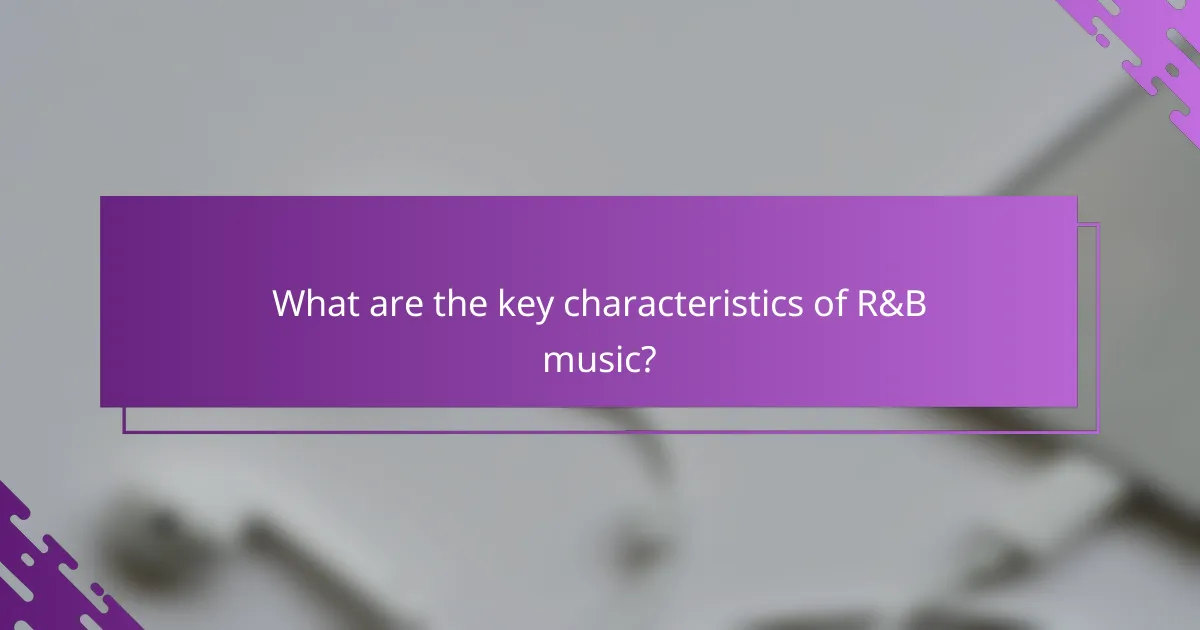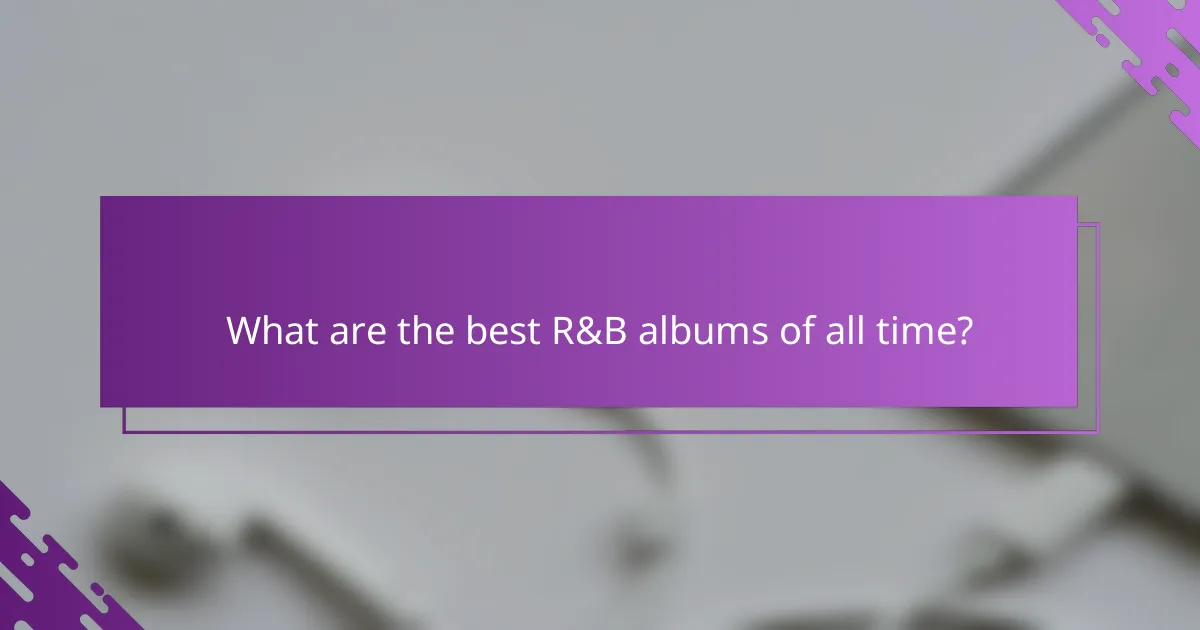R&B music is a genre defined by its soulful vocals, emotional depth, and infectious rhythmic grooves. It creates a powerful connection with listeners through heartfelt lyrics and intricate instrumentation, often exploring themes of love, heartache, and personal journeys. Contemporary artists continue to evolve this rich tradition, infusing it with fresh sounds and perspectives.

How does R&B music evoke emotional expression?
R&B music evokes emotional expression through its rich vocal techniques, compelling lyrics, and intricate instrumentation. These elements work together to create a deep connection with listeners, allowing them to feel the artist’s emotions and experiences.
Use of soulful vocals
Soulful vocals are a hallmark of R&B, characterized by their warmth and expressiveness. Singers often employ techniques such as melisma, where they stretch a single syllable over multiple notes, enhancing emotional delivery. This vocal style can convey a range of feelings, from joy to heartbreak, making the music relatable.
Artists like Aretha Franklin and Marvin Gaye exemplify this use of soulful vocals, drawing listeners into their emotional narratives. The power and nuance in their singing can evoke strong feelings, making the vocal performance a central element of R&B’s emotional impact.
Lyric storytelling
Lyric storytelling in R&B focuses on personal experiences and relatable themes, such as love, loss, and resilience. The lyrics often reflect real-life situations, allowing listeners to connect with the stories being told. This narrative style invites audiences to engage with the music on a deeper level.
Many R&B songs feature vivid imagery and emotional honesty, which can resonate with listeners’ own experiences. For example, tracks that explore heartbreak often use metaphors and similes to articulate feelings that many can relate to, enhancing the overall emotional experience.
Instrumentation and arrangement
The instrumentation and arrangement in R&B music play a crucial role in setting the emotional tone. Smooth bass lines, rhythmic grooves, and lush harmonies create a rich soundscape that complements the vocals. Instruments like the piano, guitar, and horns are commonly used to add depth and texture to the music.
Moreover, the arrangement often allows for dynamic shifts, moving from soft, intimate moments to powerful crescendos. This contrast can amplify the emotional expression, drawing listeners into the highs and lows of the song. Careful attention to these musical elements is essential for crafting an impactful R&B track.

What are the key characteristics of R&B music?
R&B music is characterized by its soulful vocals, emotional expression, and rhythmic grooves. These elements combine to create a genre that resonates deeply with listeners, often reflecting themes of love, heartache, and personal experiences.
Rhythmic grooves
Rhythmic grooves in R&B are essential for setting the mood and engaging listeners. They often feature syncopated beats and a strong backbeat, which create a laid-back yet danceable feel. Drummers and bass players typically work closely together to establish a solid foundation that supports the melodic elements.
Common instruments used to create these grooves include electric bass, drums, and keyboards. The interplay between these instruments can range from subtle to prominent, depending on the song’s overall vibe.
Melodic structure
The melodic structure of R&B music often incorporates smooth, flowing lines that emphasize emotional expression. Melodies typically use a mix of major and minor scales, allowing for a wide range of feelings from joy to melancholy. Many R&B songs follow a verse-chorus format, making them accessible and memorable.
Songwriters frequently employ techniques like call-and-response and repetition to enhance the melodic appeal. This creates a sense of familiarity and connection, drawing listeners into the emotional landscape of the song.
Vocal techniques
Vocal techniques in R&B are crucial for conveying the genre’s emotional depth. Singers often use techniques such as melisma, where multiple notes are sung on a single syllable, to add expressiveness to their performances. This technique allows vocalists to showcase their range and emotional intensity.
Additionally, breath control and dynamics play a significant role in R&B singing. Artists may vary their volume and intensity throughout a song, creating a captivating listening experience. Common pitfalls include over-singing or losing the emotional connection, so maintaining authenticity is key.

Which artists define modern R&B music?
Modern R&B music is characterized by its blend of soulful vocals, emotional expression, and rhythmic grooves, with several artists at the forefront of this genre. Key figures like H.E.R., Bruno Mars, and Janelle Monáe have significantly shaped contemporary R&B, each bringing their unique style and influence.
H.E.R.
H.E.R. has emerged as a defining voice in modern R&B, known for her powerful vocals and poignant songwriting. Her music often explores themes of love, heartbreak, and self-discovery, resonating deeply with listeners. Tracks like “Focus” and “Best Part” showcase her ability to blend traditional R&B elements with contemporary sounds.
Her use of live instrumentation and emotive lyrics sets her apart, making her a standout artist in the genre. H.E.R. has received multiple Grammy Awards, reflecting her impact and recognition within the music industry.
Bruno Mars
Bruno Mars is a versatile artist who seamlessly fuses R&B with pop, funk, and soul, creating infectious tracks that appeal to a wide audience. His energetic performances and catchy melodies, as seen in hits like “24K Magic” and “Versace on the Floor,” highlight his ability to craft memorable songs that celebrate love and joy.
Mars’ retro influences and modern production techniques allow him to bridge the gap between classic R&B and contemporary music, making him a significant figure in the genre. His numerous awards, including multiple Grammys, underscore his influence and popularity.
Janelle Monáe
Janelle Monáe is known for her innovative approach to R&B, blending genres and incorporating elements of funk, soul, and hip-hop. Her concept albums, such as “Dirty Computer,” explore themes of identity, empowerment, and social justice, pushing the boundaries of traditional R&B. Monáe’s unique style and theatrical performances set her apart as a visionary artist.
With her distinct sound and bold artistic choices, Monáe has garnered critical acclaim and a dedicated fanbase. Her work continues to inspire a new generation of artists within the R&B landscape, making her a key player in the genre’s evolution.

How has R&B music evolved over the decades?
R&B music has transformed significantly since its inception, reflecting changes in culture, technology, and musical influences. From its roots in the 1940s to contemporary styles, R&B has continuously adapted, incorporating various genres and elements to resonate with new audiences.
Influence of hip-hop
The rise of hip-hop in the late 20th century profoundly impacted R&B music, leading to a fusion of styles that emphasized rhythm and lyrical storytelling. Artists began to incorporate rap verses into their songs, creating a more dynamic and engaging listening experience.
This blend has resulted in subgenres like hip-hop soul, where artists such as Mary J. Blige and Usher have successfully merged smooth vocals with hip-hop beats. This evolution has broadened the appeal of R&B, attracting younger listeners and expanding its reach across diverse demographics.
Integration of electronic elements
In recent years, R&B has increasingly embraced electronic music, utilizing synthesizers, drum machines, and digital production techniques. This shift has allowed artists to experiment with soundscapes, creating a more polished and contemporary feel.
Notable examples include The Weeknd and Frank Ocean, who have incorporated ambient sounds and electronic beats into their music. This integration not only modernizes R&B but also connects it with other genres like pop and EDM, further enhancing its popularity.
Global influences
R&B’s evolution is also marked by the incorporation of global musical influences, reflecting the genre’s worldwide appeal. Artists are drawing inspiration from various cultures, blending traditional sounds with contemporary R&B elements.
For instance, the use of Afrobeat rhythms in tracks by artists like Burna Boy showcases how R&B can adapt and thrive in different cultural contexts. This global perspective enriches the genre, allowing for a diverse range of sounds and styles that resonate with audiences around the world.

What are the best R&B albums of all time?
The best R&B albums of all time showcase soulful vocals, emotional expression, and rhythmic grooves that define the genre. These albums have left a lasting impact on music and culture, influencing countless artists and resonating with listeners across generations.
“Songs in the Key of Life” by Stevie Wonder
Released in the mid-1970s, “Songs in the Key of Life” is often hailed as one of the greatest albums in R&B history. It features a rich blend of musical styles, including jazz, funk, and pop, all anchored by Wonder’s powerful and emotive vocals.
The album includes timeless tracks like “Isn’t She Lovely” and “Sir Duke,” which highlight Wonder’s ability to convey deep emotions through his music. Its intricate arrangements and socially conscious lyrics make it a must-listen for any R&B enthusiast.
“The Miseducation of Lauryn Hill” by Lauryn Hill
Lauryn Hill’s debut solo album, released in the late 1990s, is a groundbreaking work that combines R&B, hip-hop, and reggae influences. “The Miseducation of Lauryn Hill” explores themes of love, identity, and empowerment, all delivered through Hill’s stunning vocal performances.
With hits like “Doo Wop (That Thing)” and “Ex-Factor,” the album showcases Hill’s lyrical prowess and emotional depth. Its critical acclaim and commercial success solidified Hill’s place in R&B history, making it an essential listen.
“Channel Orange” by Frank Ocean
Frank Ocean’s “Channel Orange,” released in the early 2010s, is celebrated for its innovative approach to R&B. The album blends genres and features Ocean’s introspective lyrics, exploring themes of love, sexuality, and personal struggles.
Tracks like “Thinkin Bout You” and “Pyramids” highlight Ocean’s unique storytelling ability and his smooth, soulful vocal delivery. The album’s experimental sound and emotional honesty have made it a defining work in contemporary R&B, influencing a new generation of artists.

How can R&B music be used in advertising?
R&B music can enhance advertising by evoking strong emotions and creating a memorable atmosphere. Its soulful vocals and rhythmic grooves resonate with audiences, making products more relatable and appealing.
Emotional Connection
R&B music is known for its emotional depth, which can forge a strong connection between the audience and the brand. By using soulful melodies and heartfelt lyrics, advertisers can evoke feelings of nostalgia, love, or happiness, aligning the product with positive emotions.
For example, a commercial featuring a smooth R&B track can create a warm, inviting atmosphere, encouraging viewers to associate those feelings with the product being advertised. This emotional resonance can lead to increased brand loyalty and customer engagement.
Target Audience Appeal
R&B music appeals to a diverse demographic, particularly younger audiences who appreciate its contemporary sound. Brands targeting millennials and Gen Z can leverage R&B tracks to resonate with these groups, enhancing relatability and engagement.
When selecting R&B music for advertising, consider the specific characteristics of the target audience. For instance, using popular R&B artists can attract attention and create buzz, while lesser-known artists may provide a unique sound that differentiates the brand.
Brand Identity Enhancement
Incorporating R&B music into advertising can help reinforce a brand’s identity. The genre’s smooth and sophisticated qualities can elevate a brand’s image, aligning it with themes of luxury, style, and modernity.
For instance, a high-end fashion brand might use a classic R&B track to evoke a sense of elegance, while a casual lifestyle brand could opt for a more upbeat, contemporary R&B song to convey a fun, approachable vibe. This strategic choice can significantly impact how consumers perceive the brand.
